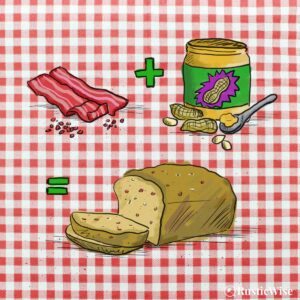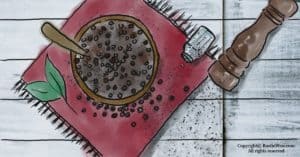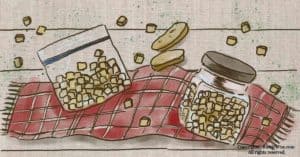How To Tell if a Potato Is Bad: 6 Telltale Signs To Look For
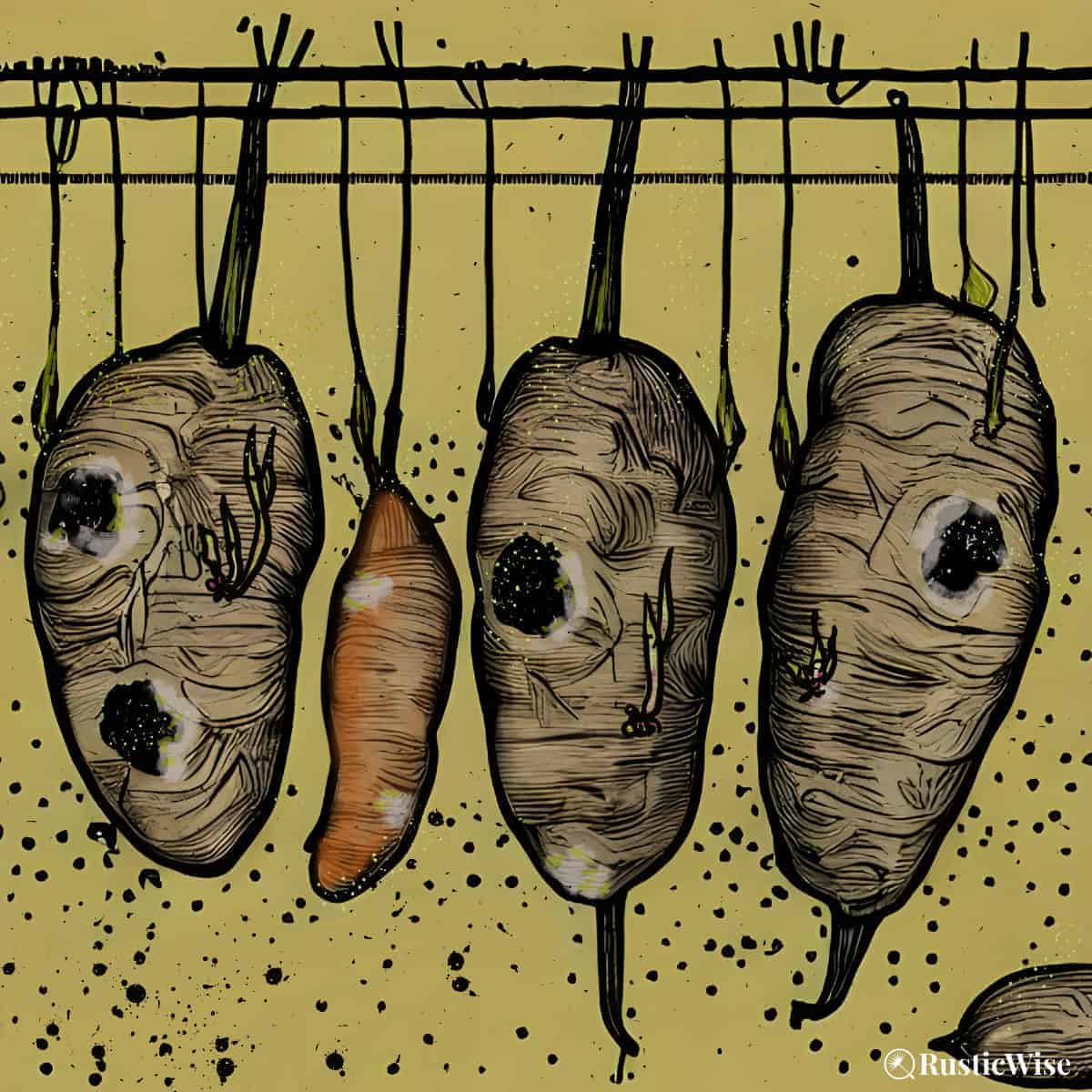
Potatoes have a long shelf life, so it’s no surprise that we often forget about them. Like all produce, spuds eventually go bad. Mushy or shriveled tubers? Sprouted spuds? Green potatoes?
If you’ve encountered a bag of potatoes that’s not exactly fresh, I’ll show you how to tell if a potato is bad (and whether to toss it or eat it). Generally, spuds with short sprouts are safe to eat once you remove the shoots. Moldy or very wrinkled tubers go in the compost bin. Proceed with caution if you have green potatoes as they contain a harmful substance solanine which can be toxic if ingested in large amounts.
Food waste is a pressing problem in many countries. This guide will help you navigate the world of spuds and learn when to toss ’em or eat ’em. Plus, I’ll cover how to store potatoes properly to extend shelf life, and what to do with spuds that are past their prime.
How to tell if a potato is bad? Look for these 6 signs
Potatoes can be kept in a cool, dark place and be safe to eat for months. But there are several ways to tell if potatoes are bad—whether you have russet, red potatoes, or sweet potatoes.
Some signs that potatoes have gone bad include:¹
- Extremely long sprouts: While sprouted potatoes with short, stubby sprouts are fine to eat (after you remove the shoots), long sprouts are another story. Spuds with long shoots have likely been stored in poor conditions (warm temperatures or exposure to bright light). These potatoes will have lost much of their nutrients and may contain higher levels of harmful compounds.
- Green potatoes: Potatoes that are completely (or mostly) green belong in the compost bin. Greening is caused by exposure to light, which increases production of chlorophyll (not harmful), and another compound that can be toxic: solanine. Solanine can cause digestive issues in small quantities, and in extreme cases, death. More on green potatoes down below!
- Bitter taste: Spuds with an “off” bitter flavor should not be eaten. The bitterness indicates the presence of solanine which can be toxic if consumed in large quantities. (Besides, nobody wants to eat a bad potato!)
- Squishy or shriveled spuds: Good potatoes should have a smooth and firm skin. Squishy or wrinkly spuds are a sign to toss them! Slightly soft spuds should be okay to eat. As potatoes contain a fair amount of water, softer potatoes are a sign of dehydration.
- Mold or rot: Perhaps the clearest sign of a rotten tater is mold, or visible signs of rot. Any signs of mold on potatoes is a clear sign that they are NOT safe to eat. Unlike “hard” foods such as some hard cheeses where it’s okay to cut off the mold part, mold spores may have spread to the inside of the tuber. So toss any moldy potatoes!
- Pungent smell: Fresh raw potatoes naturally have an earthy smell. So if your bag of spuds has a pungent odor, it’s a telltale sign they have spoiled.
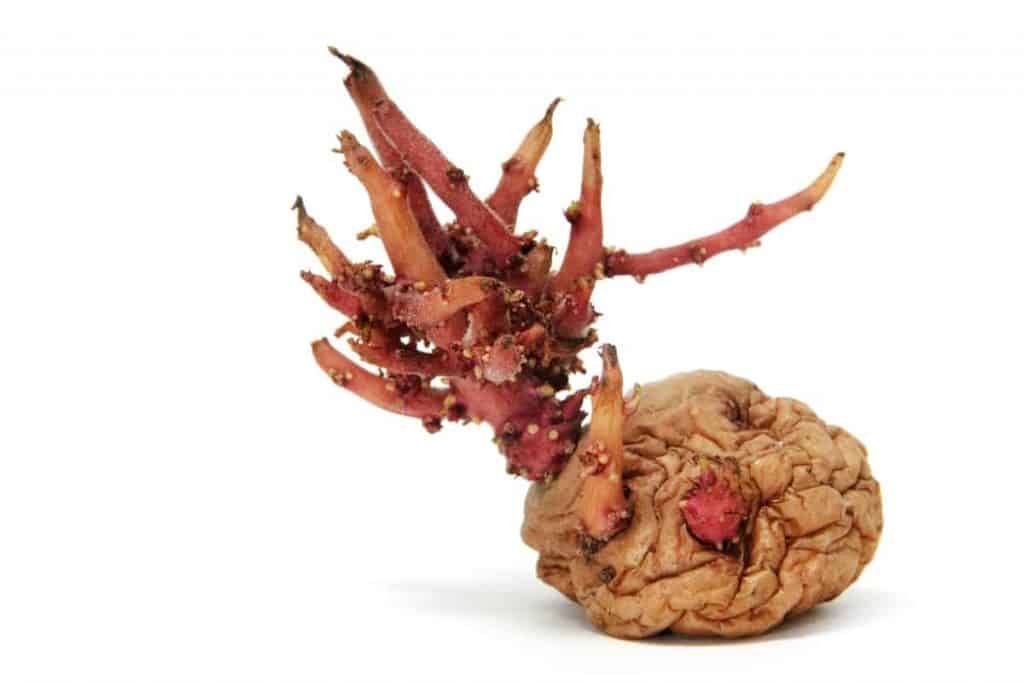
Credit: Deposit Photos
What you need to know about eating sprouted potatoes
Yes, spuds are still safe to eat if they have short or small sprouts. You can eat sprouted potatoes if you remove the sprouted part.
What about taters with lanky shoots? Potatoes with very long sprouts should be tossed. Much of the nutrients will be gone, and the flavor may be unpalatable.
Potatoes are living organisms that continue to respire and grow—all whilst sitting in your pantry or basement. If you have a batch of sprouted potatoes, it’s a sign that you’re storing them in an area that’s too warm.
Potatoes go bad more quickly if kept in the kitchen or pantry. They tend to grow sprouts sooner than those stored at cooler temperatures.
Tip: Never eat the sprouted portion or shoot of a potato. It contains high quantities of solanine which could make you sick.
Signs of freshness: how to tell a good spud from a bad one
The most obvious way to tell a fresh potato from a non-fresh one is by the way it looks and feels. Fresh tubers should feel firm, with no soft or mushy spots. The skin should be free of cuts or other types of blemishes.²
Tip: When choosing potatoes at the grocery store, choose ones that are round and smooth and not irregularly shaped. This prevents wastage when peeling.
Green potatoes are a red flag
When you see a potato with green skin, proceed with caution. Simply put, if a potato has a few green spots, just cut off the green parts and discard. The rest of the potato should be fine to eat.
But, if the potato is green all over, toss it. It likely contains large amounts of solanine which can be toxic if ingested. Green potatoes are also very bitter tasting.
Safety note: Never feed small children green potatoes (even if you remove the green parts). Small amounts of solanine may still be present in the potato, and children are more sensitive to this compound than adults due to their small body size.
Potatoes turn green when they are exposed to sunlight. This light exposure encourages the production of shoots and also chlorophyll, which makes the plant green. Chlorophyll content is not harmful to humans. However, sunlight also induces the development of a possibly toxic alkaloid: solanine.³
Solanine causes bitterness in potatoes and can be toxic. Very green potatoes contain higher levels of solanine than regular spuds.
Factors that affect greening in potatoes are the duration of light exposure, intensity of light, and overall temperature.
What happens if you eat old or green potatoes?
Potatoes can be dangerous to eat if spoiled. The green layer that you see on green potatoes comes from solanine. Solanine is a poisonous toxin that’s harmful to humans, even in low dosages.
Young children are especially susceptible to the effects of solanine poisoning due to their small body size.
According to the National Capital Poison Center, high levels of solanine and chaconine (another potentially toxic compound), “…cause toxicity through cell disruption leading to gastrointestinal symptoms such as vomiting, abdominal pain, and diarrhea. Some people may also experience headache, flushing, confusion, and fever. There have been a few cases of death from eating toxic potatoes. The onset of symptoms is typically within a few hours but can be as delayed as long as a day.”⁴
While these symptoms sounds awful, the good news is you would have to consume a LOT of green potatoes to get very sick. Most people will only have a bite or two before the bitterness makes them stop.
Tips on storing raw potatoes
Store potatoes in a cool, dark, and humid place away from direct sunlight. For best storage, ensure the room is well-ventilated.
The ideal storage temperature for tubers is ideally between 40 and 50 degrees Fahrenheit (4–10 degrees Celsius). Any temperatures above 50 degrees Fahrenheit (or 10 degrees Celsius) encourages sprouting.²
When buying grocery store spuds, take potatoes out of their original packaging if it comes in a plastic bag. Storing your whole, uncooked potatoes in an airtight container, for example, would be a bad idea. This is because they need fresh air circulation. Place them in a cardboard box in a cool room such as the basement.
If you’re looking to store them longer than a few months, you should consider cooking and freezing them instead.
Can you store raw potatoes in the fridge?
Raw potatoes should not be stored in the fridge. Potatoes are a starchy tuber. The colder temperatures convert the starches to sugar. While this may not sound so bad, the newly created sugars cause potatoes to brown during cooking and give the cooked tubers an off-putting sweet taste.¹
Can you freeze whole potatoes?
No, tubers are largely comprised of water and won’t hold up to freezing temperatures. So don’t bother to freeze potatoes that are raw!
If you have a large bumper crop of potatoes from this year’s harvest, it’s best to cook them before freezing. So boil or mash those taters to save for later!
The shelf life of potatoes: raw, cooked, or frozen
According to FoodSafety.gov, raw, whole potatoes when stored in the pantry should be eaten within 1–2 months from the date of purchase.⁵
As for cooked potatoes (and other cooked veggies), the USDA says they should be kept in the refrigerator for 3–4 days.⁶
Frozen cooked potatoes should be consumed within 1 year. However, frozen mashed potatoes for example, may suffer some quality loss. (All the more reason to defrost and enjoy sooner rather than later.)
What to do with old potatoes
Some potatoes aren’t bad enough to toss, but not fresh enough to make the star of the show. Here are a few ways to use up (slightly) old potatoes:
- Shred or dice: Shred to make hash browns or potato pancakes.
- Mash: Mash ’em! Enjoy them all on their own, or make Shepherd’s pie.
- Potato salad: Slightly old potatoes would make a great addition to celery, onions, hard-boiled eggs, and other potato salad ingredients.
And if those spuds are truly not worthy of eating, remember to compost them!
Related questions
Are potatoes healthy for you?
Potatoes are a source of carbohydrates and contain vitamins C and B-1, as well as iron, niacin, and potassium. A medium-sized spud contains less than 100 calories.²
Is it safe to eat raw potatoes?
While it won’t kill you to eat a bite or two of a raw tuber (or perhaps even a whole spud), it’s not recommended for several reasons. One is the taste—the texture and bitter flavor is off-putting.
Second, eating large amounts of raw potatoes may cause digestive issues and stomach cramps. A tuber is primarily comprised of starch. When you cook potatoes, this starch is made more easily digestible. However, in raw form, raw starches are not easily broken down, giving your digestive system a tough task!
For those curious about eating a raw tater, ensure you thoroughly wash and peel the skin before biting into it. And never eat raw green potatoes!
👉If you like this post, see our Timeless Food Storage and Preservation Guide.
Would you like more timeless tips via email?
Fun tips to help you live an independent, self-sustaining lifestyle. Opt-out at any time.


References
- Geiger, Marlene (04 December 2017). “Potatoes . . . when to toss?“, Iowa State University Extension. Accessed October 2022.
- University of Alaska Fairbanks, Potatoes, Vegetable Factsheets, https://cespubs.uaf.edu/publications?s=potatoes&submit=Search+Now. Accessed October 2022.
- University of Alaska Fairbanks, Green Potatoes: Causes and Concerns, Vegetable Factsheets, https://cespubs.uaf.edu/publications?s=potatoes&submit=Search+Now. Accessed October 2022.
- National Capital Poison Center, Are Sprouted Potatoes Safe to Eat?, https://www.poison.org/articles/are-green-potatoes-safe-to-eat-191. Accessed October 2022.
- FoodSafety.gov, Potatoes, https://www.foodsafety.gov/keep-food-safe/foodkeeper-app. Accessed October 2022.
- Ask USDA, How long can you store cooked potatoes?, https://ask.usda.gov/s/article/How-long-can-you-store-cooked-potatoes. Accessed October 2022.

Author: Theresa Tesolin
Theresa is co-founder of RusticWise. She helps people unleash their inner DIY spirit by encouraging them to get dirty and make or grow something from scratch.


